Decorating a vegetable garden with your own hands. We equip a flower garden on the site - choose the best option
In this article we will tell you what types of flower beds exist today, list their main features and characteristics. Let's figure out which plant is suitable for each of the options for arranging a flower garden, as well as which style of landscape design each of them suits.
Before proceeding to the description of the types of flower beds, we immediately note that they are all divided into two large groups:
- Regular flowers. They differ in strict forms, symmetry, they are equipped according to a pre-drawn plan. Such flower beds are not so common in summer cottages, as they require constant care, in particular, formative cuttings of plants. In addition, it is quite difficult to create such a composition with clear lines, based on the principles of classicism.
- Irregular flower beds. More natural, simple and relaxed. They do not require daily care, therefore they are more popular among summer residents.
A vivid example of a regular flower garden - an indispensable element in creating a garden in the French regular style
Border
The border flower garden is a continuous narrow strip of plants of the same species. The width of the border should not exceed 60 centimeters.
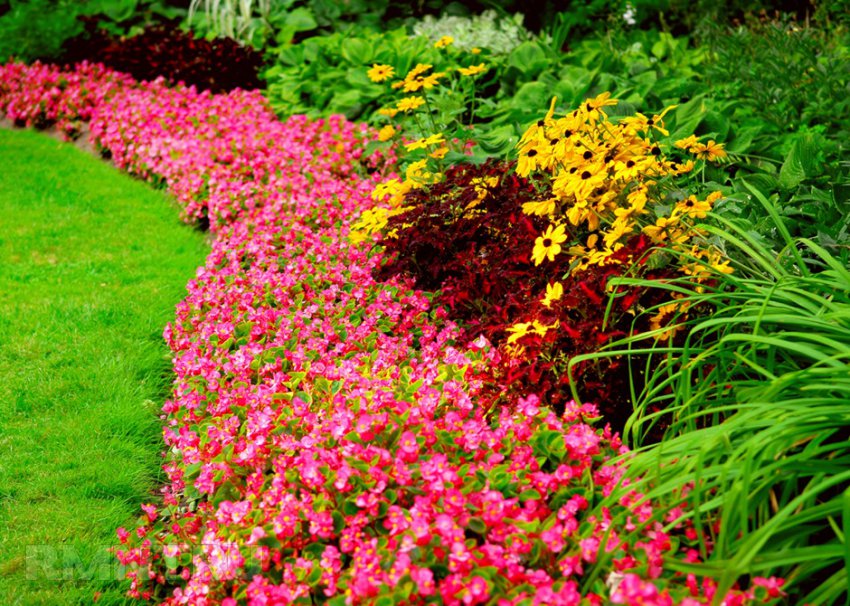 For the arrangement of the border, no additional materials are needed - it is created with the help of the plants themselves and most often serves as the finishing touch to the entire composition. With the help of a border from a narrow strip of the same colors, separate areas of the site are often separated, framed by paths or lawns. The border flower garden is widely used in different styles of landscape design.
For the arrangement of the border, no additional materials are needed - it is created with the help of the plants themselves and most often serves as the finishing touch to the entire composition. With the help of a border from a narrow strip of the same colors, separate areas of the site are often separated, framed by paths or lawns. The border flower garden is widely used in different styles of landscape design.
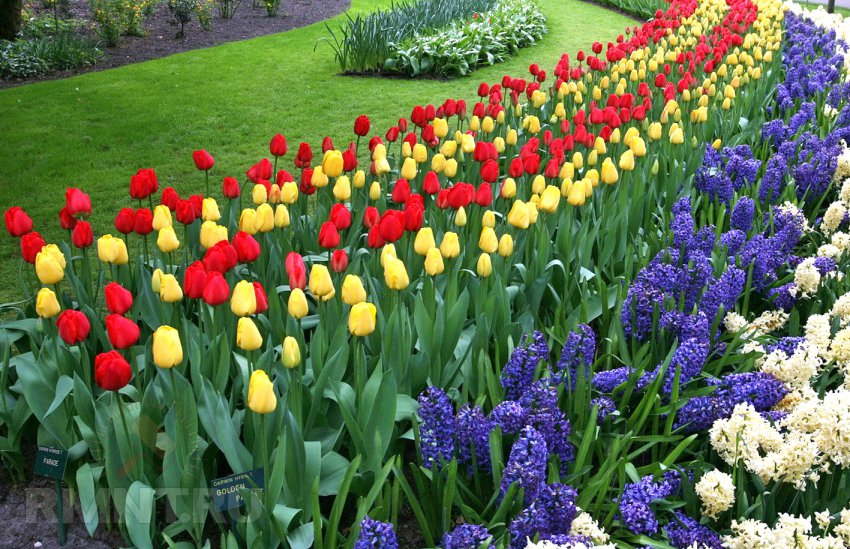 Curbs of tulips, daffodils, phloxes, delicate pansies, forget-me-nots, small carnations, marigolds, daisies, petunias, undersized varieties of asters look beautiful. Flowers can be of different shades, but always of the same type - this is one of the features of the border
Curbs of tulips, daffodils, phloxes, delicate pansies, forget-me-nots, small carnations, marigolds, daisies, petunias, undersized varieties of asters look beautiful. Flowers can be of different shades, but always of the same type - this is one of the features of the border
flowerpot
Flower garden in a vase, wooden tub, decorative vase, flower pot or some other container - one of the most popular varieties used for landscaping areas without open ground, such as terraces or patios.
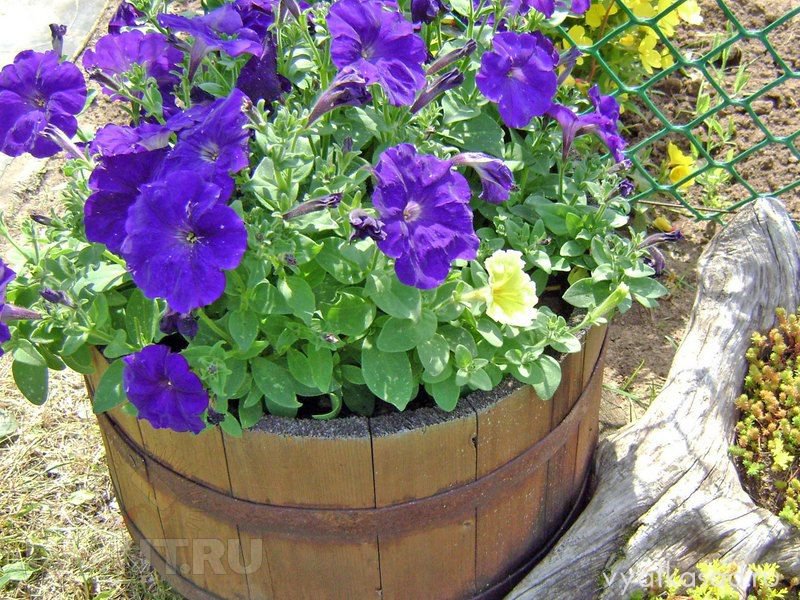 When arranging a flower garden-vase, the main thing is the choice of the “container” itself. It can be both inexpensive plastic flowerpots and such wooden tubs. Flower beds-pots can be found as in an ordinary garden around country house, and in the park in the English style
When arranging a flower garden-vase, the main thing is the choice of the “container” itself. It can be both inexpensive plastic flowerpots and such wooden tubs. Flower beds-pots can be found as in an ordinary garden around country house, and in the park in the English style
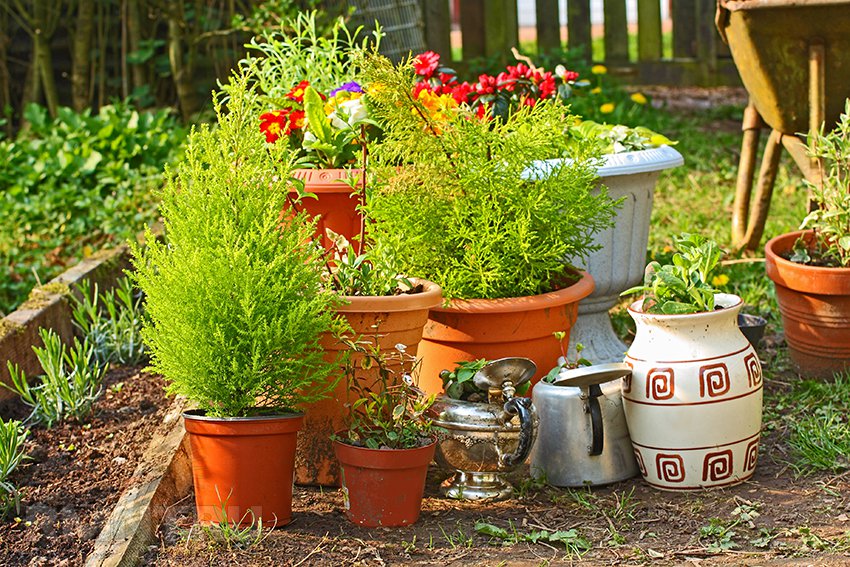 The choice of plants for a flowerpot depends on the volume of the selected container. So, a lush petunia will look great in a high decorative vase, pansies and multi-colored violets in a small low flowerpot, a tall decorative bush in a massive tub
The choice of plants for a flowerpot depends on the volume of the selected container. So, a lush petunia will look great in a high decorative vase, pansies and multi-colored violets in a small low flowerpot, a tall decorative bush in a massive tub
Flowerbed
A flower bed can be safely called the most widespread option for arranging a flower garden. It has a clear geometric shape - round, square, rectangular or oval. Usually flower beds rise above the site and are framed by a border of flowers or various materials. On average, the area of a standard flower bed is two to three square meters.
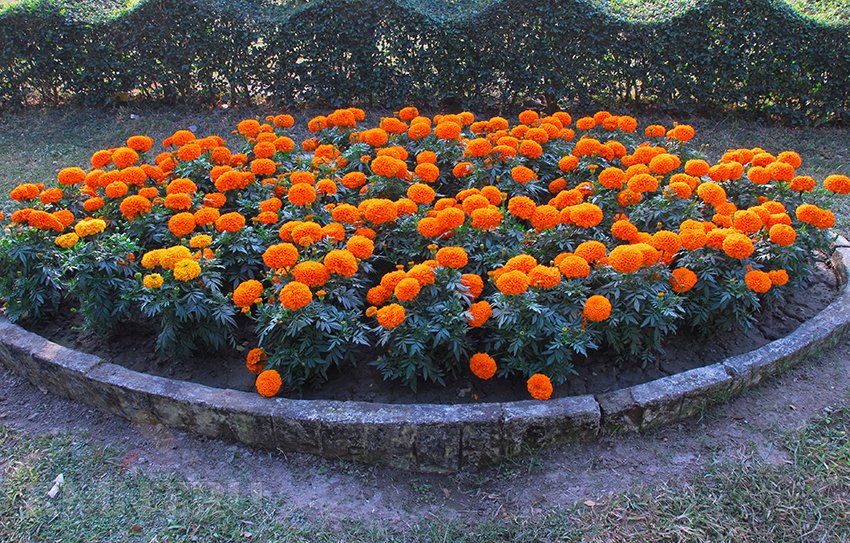 When arranging a flower bed, special attention is paid to the design of its borders. It can be a regular curb for paving slabs, wooden fence chik, bricks, decorative plates and even an old tire. Fertile soil should be added inside in order to raise the flower bed above the level of the site and separate it from the surrounding space. Flowerbeds are almost an essential attribute of all styles of landscape design, as they come in a wide variety of shapes and sizes, as well as provide a wide variety of plants.
When arranging a flower bed, special attention is paid to the design of its borders. It can be a regular curb for paving slabs, wooden fence chik, bricks, decorative plates and even an old tire. Fertile soil should be added inside in order to raise the flower bed above the level of the site and separate it from the surrounding space. Flowerbeds are almost an essential attribute of all styles of landscape design, as they come in a wide variety of shapes and sizes, as well as provide a wide variety of plants.
 The choice of plants for a flower bed is limited, in principle, only by the imagination and wishes of the owner. These may be the most different combinations colors. Traditionally, shorter plants are planted at the edges, tall ones in the center of the flower bed. Often such compositions are complemented by MAFs, for example, garden figures
The choice of plants for a flower bed is limited, in principle, only by the imagination and wishes of the owner. These may be the most different combinations colors. Traditionally, shorter plants are planted at the edges, tall ones in the center of the flower bed. Often such compositions are complemented by MAFs, for example, garden figures
rockery
Rockery is a flower garden, on the area of which plants are combined with natural or artificial stone. Such stone-flower compositions are very popular today, as they do not require constant care, are unpretentious and compare favorably with ordinary flower beds.
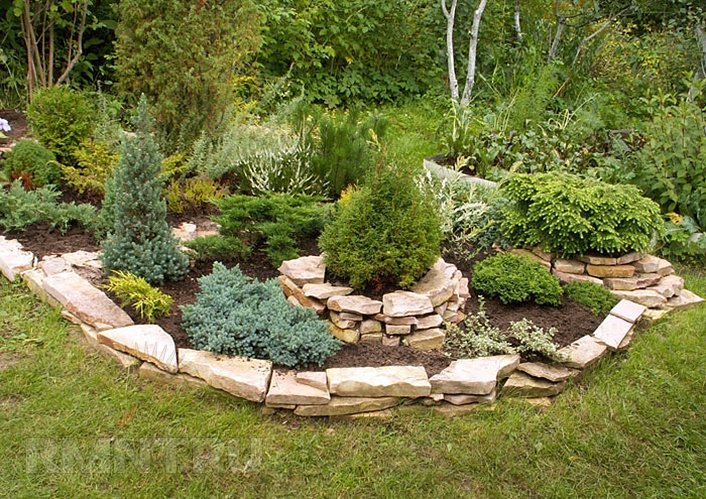 When arranging rockeries, the main building material is natural or artificial stone. The stones will also serve to decorate the borders of the flower garden, and highlight individual zones, and decorate the central part. In this case, the stones should differ in shape and texture. Rockery will look harmoniously in an English landscape style, in a Japanese or Chinese garden
When arranging rockeries, the main building material is natural or artificial stone. The stones will also serve to decorate the borders of the flower garden, and highlight individual zones, and decorate the central part. In this case, the stones should differ in shape and texture. Rockery will look harmoniously in an English landscape style, in a Japanese or Chinese garden
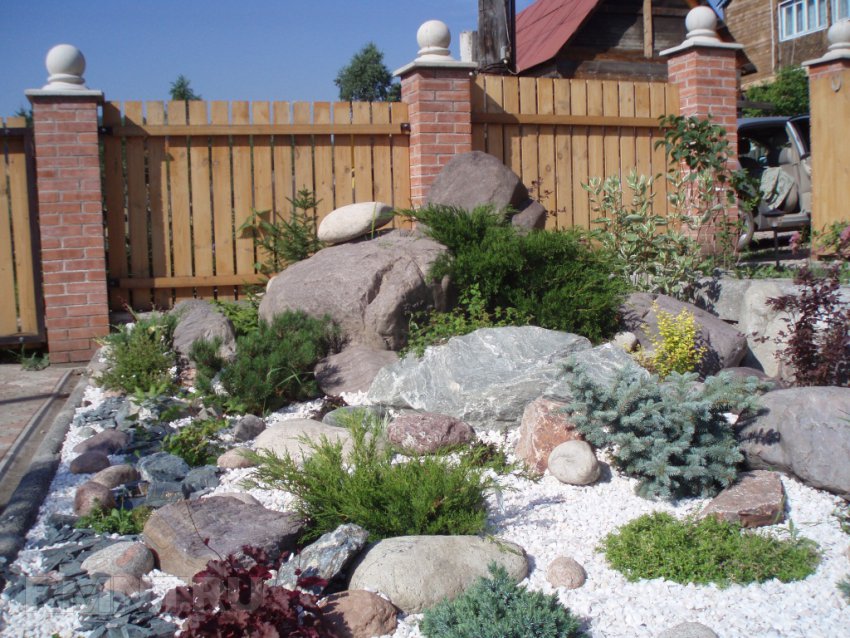 Evergreens are great for rockeries. coniferous shrubs, for example, dwarf arborvitae and juniper. As for flowers, it is better to prefer hyacinths, wild violets, crocuses, Siberian irises. Do not forget about ground cover plants, in particular mosses, saxifrage and phlox, which will take their place in the crevices between the stones.
Evergreens are great for rockeries. coniferous shrubs, for example, dwarf arborvitae and juniper. As for flowers, it is better to prefer hyacinths, wild violets, crocuses, Siberian irises. Do not forget about ground cover plants, in particular mosses, saxifrage and phlox, which will take their place in the crevices between the stones.
Rose garden
Rosary - a flower garden dominated by the "queen of flowers" - a rose. Roses in such a flower garden can be the most different types, shapes, shades and sizes, such a variety can become the main highlight of the rose garden.
 Usually, when arranging a rose garden, additional materials are not required - only the plants themselves. However, if you choose tall climbing roses, you will need a reliable support for them, for example, a beautiful wattle fence, metal carcass or decorative stand. The rose garden can become a bright decoration of a baroque garden, but it will also look great on a regular one. suburban area, which does not pretend to a certain style of landscape design
Usually, when arranging a rose garden, additional materials are not required - only the plants themselves. However, if you choose tall climbing roses, you will need a reliable support for them, for example, a beautiful wattle fence, metal carcass or decorative stand. The rose garden can become a bright decoration of a baroque garden, but it will also look great on a regular one. suburban area, which does not pretend to a certain style of landscape design
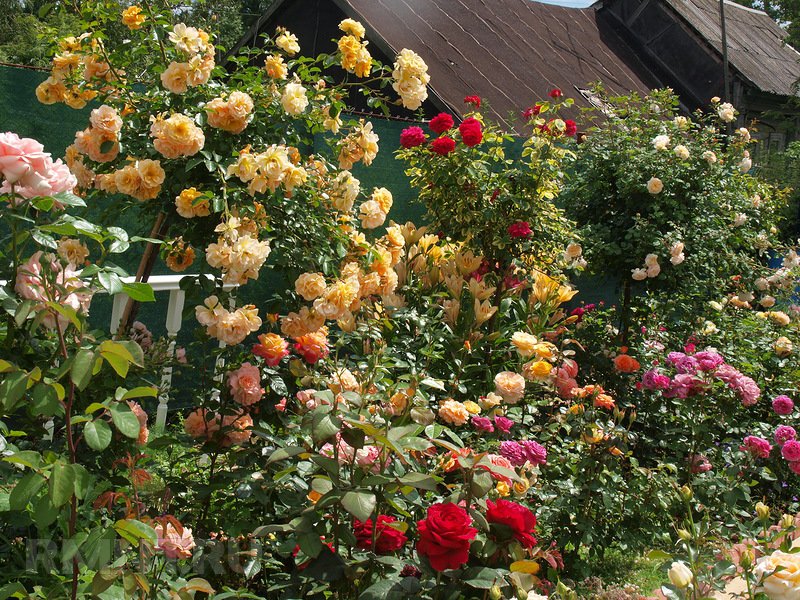 To create a rose garden, any kind of roses is suitable - from lush exotic floribundas to elegant dwarf polyanthus varieties
To create a rose garden, any kind of roses is suitable - from lush exotic floribundas to elegant dwarf polyanthus varieties
Mixborder
Mixborder, as the name implies, is a real mix of plants, a multi-row flower garden, which harmoniously combines various flowers, conifers and ornamental shrubs. Mixborders can be rectangular or irregularly elongated.
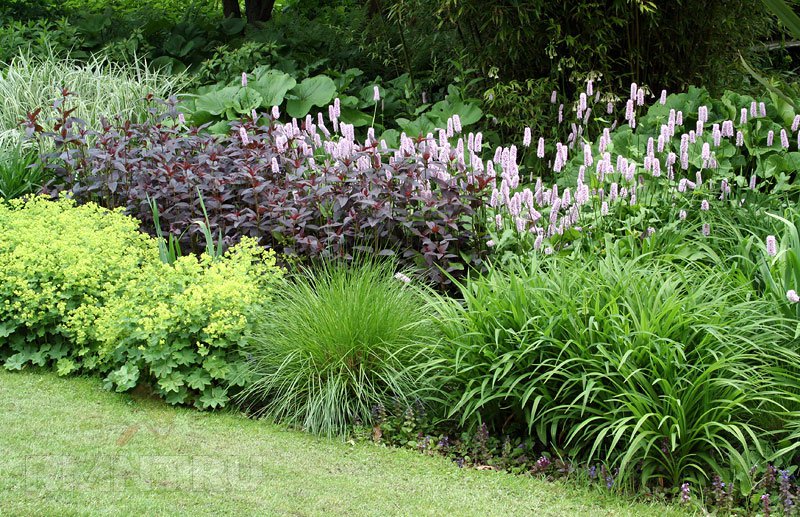 A mixborder can be located in the center of a lawn, along a path or a country house, or separate different sections of the garden. Such flower beds usually emphasize the boundaries of the plots on their own, so they do not need additional fences or borders. Mixborders are widely used in different styles of garden decoration.
A mixborder can be located in the center of a lawn, along a path or a country house, or separate different sections of the garden. Such flower beds usually emphasize the boundaries of the plots on their own, so they do not need additional fences or borders. Mixborders are widely used in different styles of garden decoration.
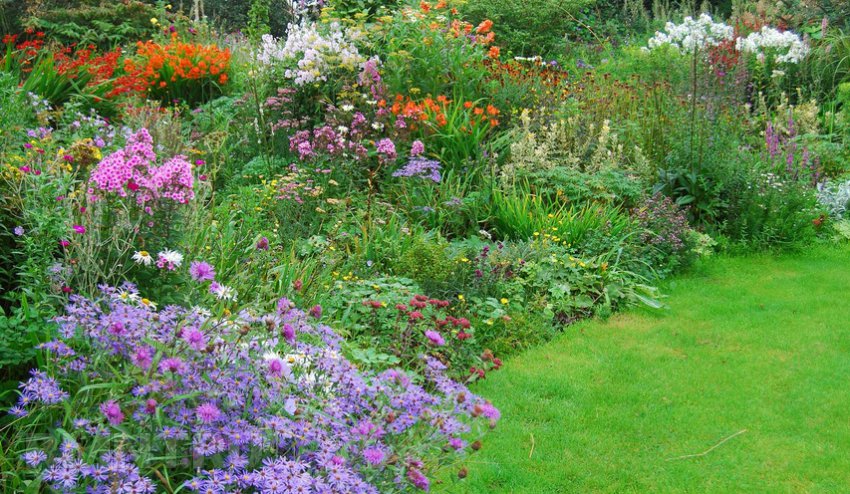 Mixborder is always distinguished by a wide variety of plants. The first strip is usually occupied by low flowers, for example, nasturtiums, and in the background, taller ones, in particular, Siberian irises or flowering shrubs
Mixborder is always distinguished by a wide variety of plants. The first strip is usually occupied by low flowers, for example, nasturtiums, and in the background, taller ones, in particular, Siberian irises or flowering shrubs
Rabatka
Rabatka - a flower garden in the form of a ribbon with a width of 50 to 150 centimeters, the length is limited only by the size of the site itself. Most often, such flowering stripes are located along the path; they are often found in parks and squares. Sometimes stripes of flowering plants are combined with geometric shapes in the rabatka.
 Unlike the border, which also usually stretches along garden paths, the border consists of several strips of plants. Such flower beds do not need additional borders, it is quite simple to equip them - the main thing is to properly break the beds and plant seeds or purchased flowers. Traditionally, there are three strips of different plants in the discount, but sometimes their number can reach 5–8. Rabatka will look good in a park designed in a regular French style, as it has clear shapes
Unlike the border, which also usually stretches along garden paths, the border consists of several strips of plants. Such flower beds do not need additional borders, it is quite simple to equip them - the main thing is to properly break the beds and plant seeds or purchased flowers. Traditionally, there are three strips of different plants in the discount, but sometimes their number can reach 5–8. Rabatka will look good in a park designed in a regular French style, as it has clear shapes
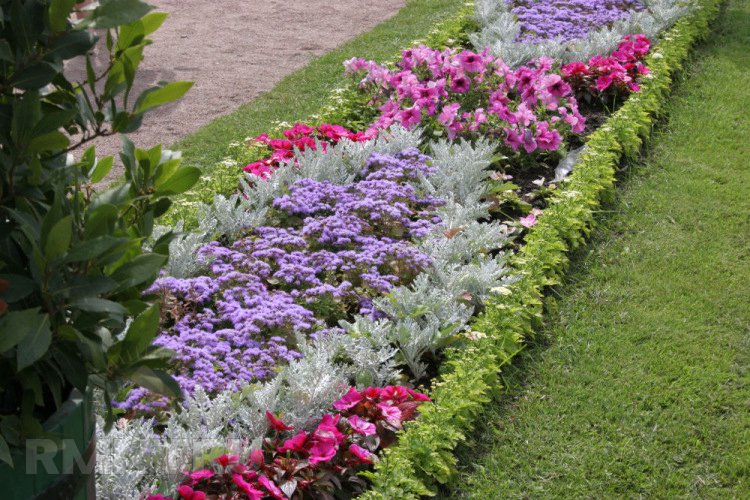 For arranging a rabatka, it is better to choose flowers such as irises, petunias, carnations, geraniums, sedum, forget-me-nots, asters, peonies, ageratum, decorative sunflowers and violets. When choosing flowers, you should be guided by the time of their flowering (it is good when the plants bloom at the same time), colors and height
For arranging a rabatka, it is better to choose flowers such as irises, petunias, carnations, geraniums, sedum, forget-me-nots, asters, peonies, ageratum, decorative sunflowers and violets. When choosing flowers, you should be guided by the time of their flowering (it is good when the plants bloom at the same time), colors and height
front garden
The front garden is a flower garden, laid out in a fenced area in front of the house. As the real face of the plot, the front garden can be of different sizes and shapes, however, in without fail has well-defined boundaries in the form of a fence, curb or hedge. The length of the front garden is always limited by the adjacent wall of the house.
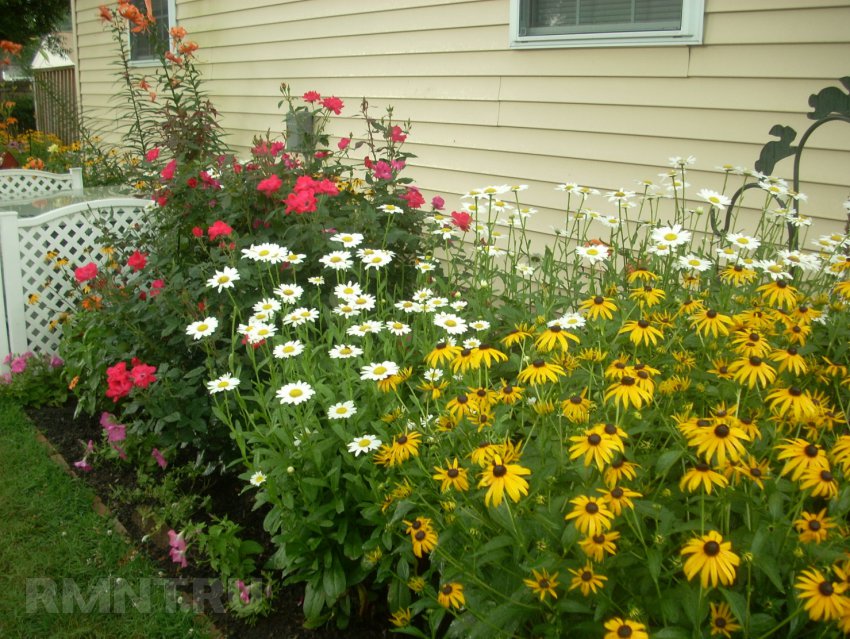 When arranging a front garden, first of all, you should take care of the fence. It can be a low fence made of wooden boards, an openwork lattice, a high solid fence made of a metal profile - it all depends on the characteristics of your site, the desire to hide from the prying eyes of passers-by or, on the contrary, to flaunt a beautiful, well-groomed front garden. The design style of this corner of a summer house or a personal plot can be very different - from rustic to minimalistic
When arranging a front garden, first of all, you should take care of the fence. It can be a low fence made of wooden boards, an openwork lattice, a high solid fence made of a metal profile - it all depends on the characteristics of your site, the desire to hide from the prying eyes of passers-by or, on the contrary, to flaunt a beautiful, well-groomed front garden. The design style of this corner of a summer house or a personal plot can be very different - from rustic to minimalistic
 For the front garden, you can choose absolutely any plants, depending on the chosen design style. For the rustic - the usual daisies, lilies and petunias, for the high - lilac and arborvitae, for the minimalist - delicate lilies of the valley and bonsai
For the front garden, you can choose absolutely any plants, depending on the chosen design style. For the rustic - the usual daisies, lilies and petunias, for the high - lilac and arborvitae, for the minimalist - delicate lilies of the valley and bonsai
Alpine slide
Alpine hill as well as rockery is a flower garden in which plants are combined with stones. However, unlike rockeries, the alpine slide rises above the site to a height of at least a meter. In addition, if it is stones that play the main role in rockeries, then plants dominate on the alpine hill, and boulders play a secondary role.
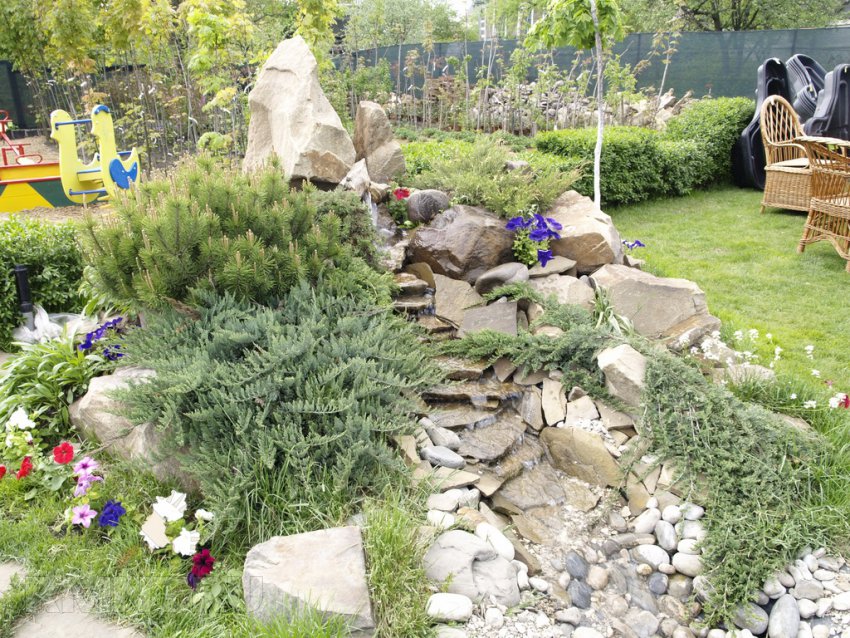 The rock garden can be placed both on a flat area and on a slope. The main thing in its arrangement - right choice stones. The most commonly used are sandstone, travertine and slate. You can create an alpine hill in different styles, as there are several varieties of such a flower garden, for example, an alpine lawn, a mountain slope or a rocky cliff
The rock garden can be placed both on a flat area and on a slope. The main thing in its arrangement - right choice stones. The most commonly used are sandstone, travertine and slate. You can create an alpine hill in different styles, as there are several varieties of such a flower garden, for example, an alpine lawn, a mountain slope or a rocky cliff
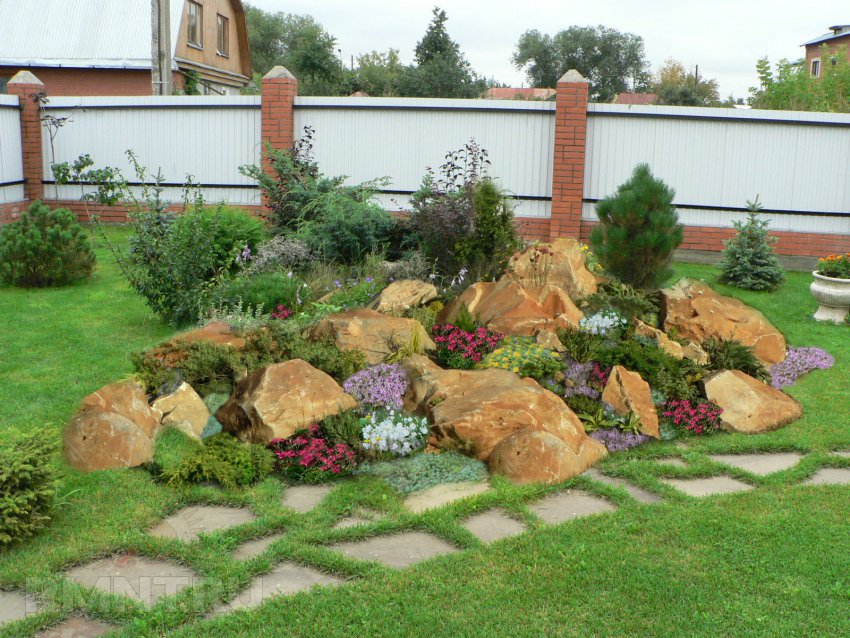 On the territory of the rock garden, plants can be planted as large groups, as well as separately. Geranium, saxifrage, lavender, carnation, Japanese maple, rosemary, dwarf roses, and azalea are good choices.
On the territory of the rock garden, plants can be planted as large groups, as well as separately. Geranium, saxifrage, lavender, carnation, Japanese maple, rosemary, dwarf roses, and azalea are good choices.
decorative vegetable garden
This type of flower garden originated two hundred years ago in France. An ornamental garden is a bed with vegetables, spices, herbs and ornamental plants fenced with a living border of flowers. The result is both a beautiful and useful composition - a flower garden and a vegetable garden - two in one.
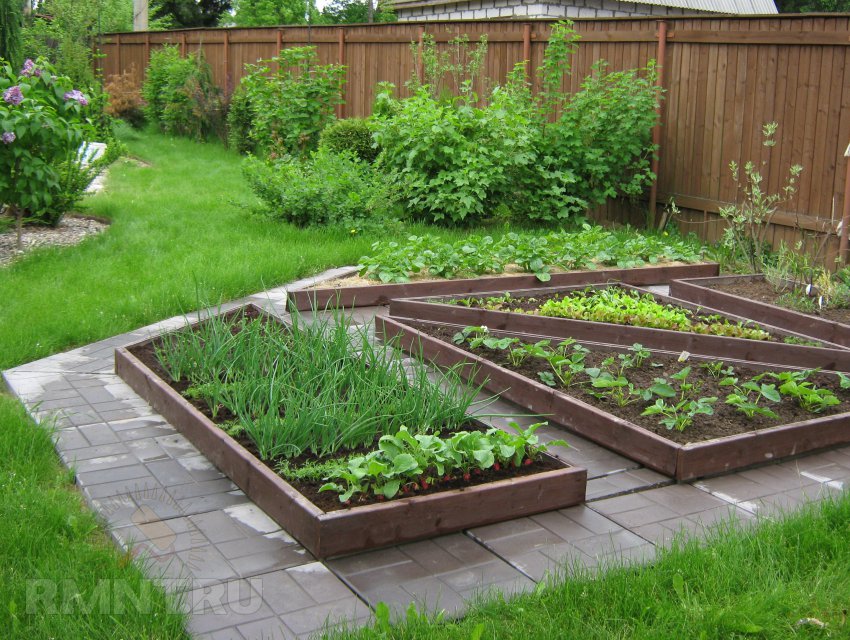 When arranging an ornamental garden, special attention is paid to convenient paths, because you will have to regularly harvest and care for the beds, so you should ensure access from all sides. You can use low fences or boxes to mark the boundaries of such a site. This is not to say that the decorative garden belongs to a certain style of landscape design. Rather, it is part of an ordinary summer cottage, the owners of which decided not only to grow vegetables and herbs for their family, but also to decorate the territory at the same time.
When arranging an ornamental garden, special attention is paid to convenient paths, because you will have to regularly harvest and care for the beds, so you should ensure access from all sides. You can use low fences or boxes to mark the boundaries of such a site. This is not to say that the decorative garden belongs to a certain style of landscape design. Rather, it is part of an ordinary summer cottage, the owners of which decided not only to grow vegetables and herbs for their family, but also to decorate the territory at the same time.
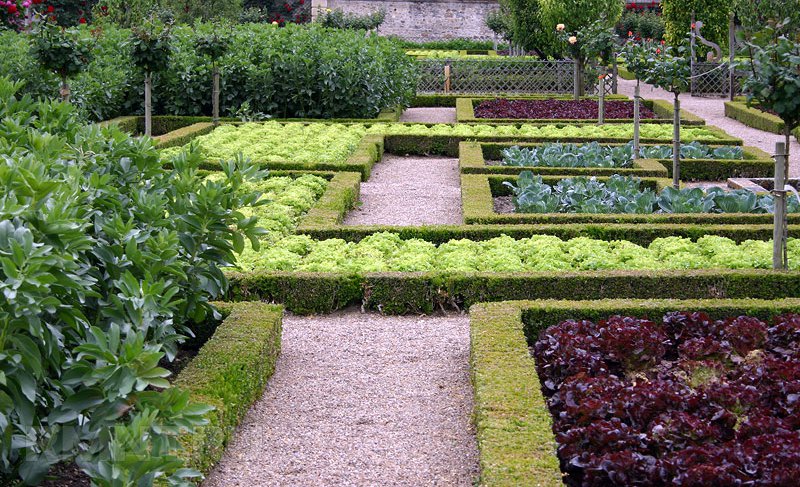 In the ornamental garden, you can grow all kinds of vegetables, for example, neat cabbages, herbs, spices. And for framing the beds and creating borders, chamomile, oregano, forest mallow and cornflower are suitable
In the ornamental garden, you can grow all kinds of vegetables, for example, neat cabbages, herbs, spices. And for framing the beds and creating borders, chamomile, oregano, forest mallow and cornflower are suitable
Country flower garden
Such a rustic flower garden implies the presence of some thematic attributes, for example, an old cart or a wheel from it, a broken stool or a cast-iron for a Russian stove - that is, objects that emphasize the main focus and style of the composition.
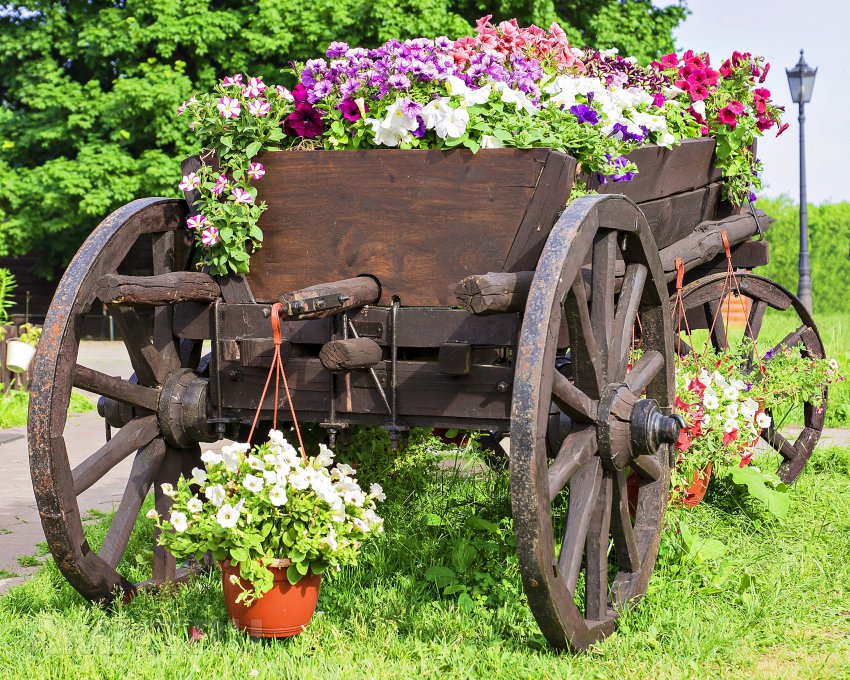 The size and shape of a country flower garden can be very different. We advise you to start with the choice of the main part, for example, such an old wheelbarrow or cart. The rest depends on your imagination. As a fence for such "rustic" flower beds, either a wattle fence or a low wooden fence without frills and unnecessary details is used.
The size and shape of a country flower garden can be very different. We advise you to start with the choice of the main part, for example, such an old wheelbarrow or cart. The rest depends on your imagination. As a fence for such "rustic" flower beds, either a wattle fence or a low wooden fence without frills and unnecessary details is used.
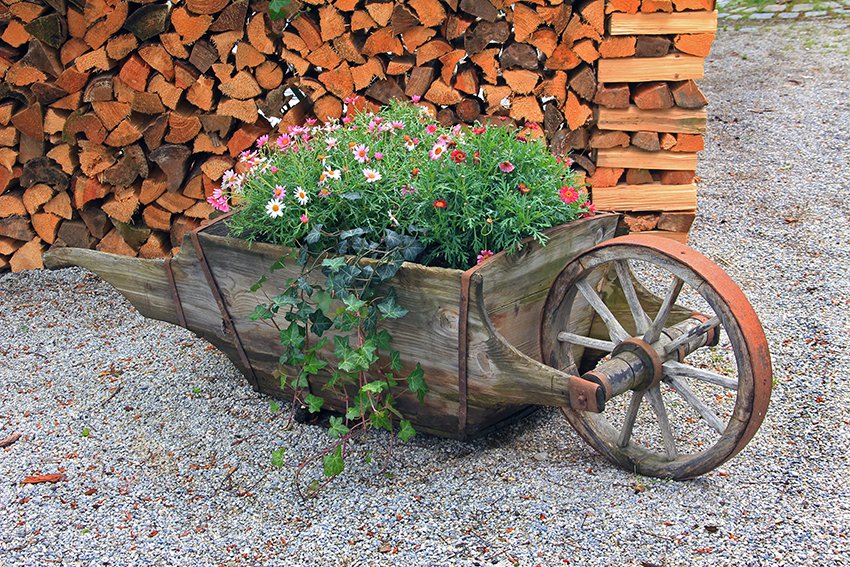 For a country flower garden, simple and unpretentious plants typical of your region are suitable. Daisies, mallows, phloxes, tiger lilies, marigolds will look great - all those flowers that will remind you of the front garden in front of your grandmother's house
For a country flower garden, simple and unpretentious plants typical of your region are suitable. Daisies, mallows, phloxes, tiger lilies, marigolds will look great - all those flowers that will remind you of the front garden in front of your grandmother's house
Modular flower garden
Modular flower garden - one of the most fashion trends landscape design. It is a strict composition based on the repetition of the same element of a certain shape and size, that is, a module. Typically, these repeating flower garden pieces are squares or rectangles, but there may be other options.
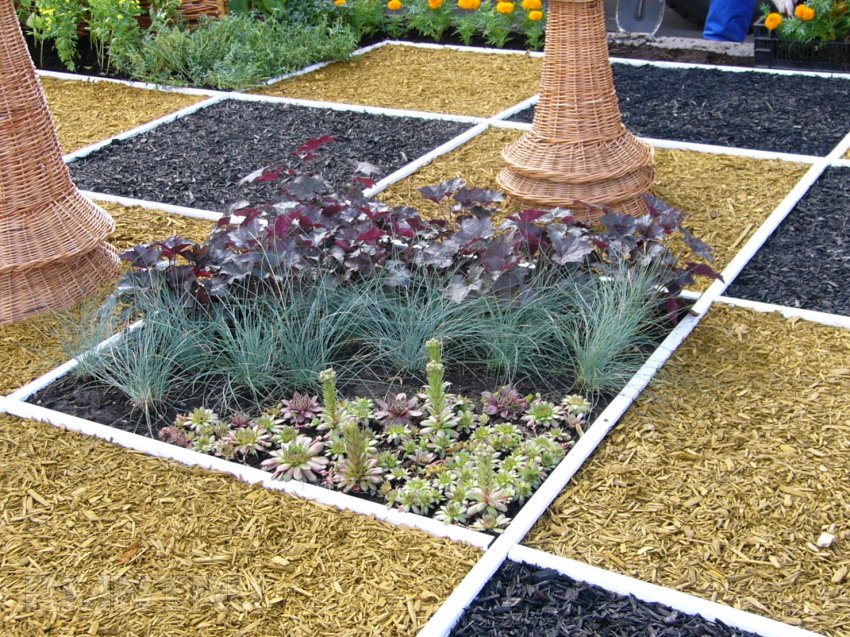 When organizing a modular flower garden, you should first divide the territory into separate sections of the same shape and size. The space between such modules can be decorated with sand, paving slabs, gravel, pebbles, pieces ceramic tiles, marble chips or sow lawn grass - just to highlight the boundaries. Due to the strict repeating form, modular lawns are widely used in regular French gardens and well-groomed English parks.
When organizing a modular flower garden, you should first divide the territory into separate sections of the same shape and size. The space between such modules can be decorated with sand, paving slabs, gravel, pebbles, pieces ceramic tiles, marble chips or sow lawn grass - just to highlight the boundaries. Due to the strict repeating form, modular lawns are widely used in regular French gardens and well-groomed English parks.
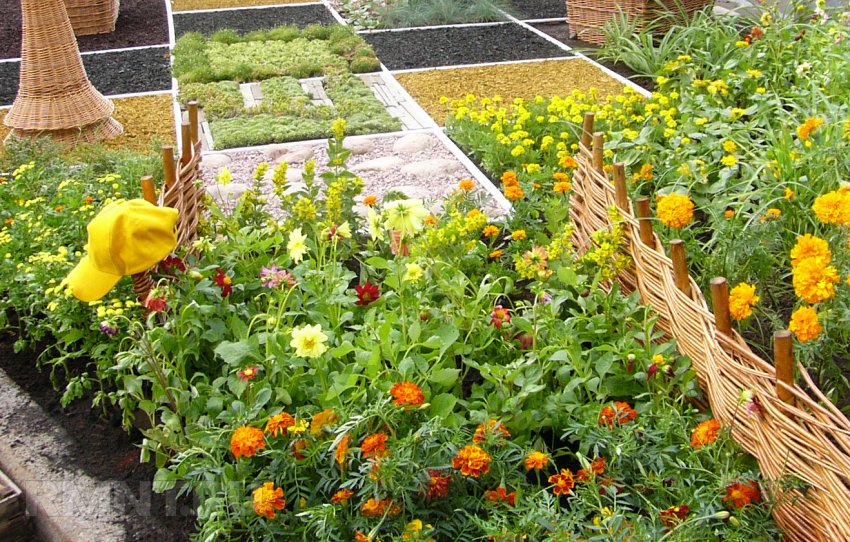 For modular flower beds, low creeping plants are usually chosen, for example, daisies, violets, nasturtiums, farbitis, marigolds and amaranths. Ground cover plants are also suitable - arabis, periwinkle, alpine and feathery carnation, yellow and green bryozoan, as well as primrose
For modular flower beds, low creeping plants are usually chosen, for example, daisies, violets, nasturtiums, farbitis, marigolds and amaranths. Ground cover plants are also suitable - arabis, periwinkle, alpine and feathery carnation, yellow and green bryozoan, as well as primrose
flower clock
In this case, we are not talking about a flower bed where plants are planted in the form of a dial, but about a flower garden where plants are collected that open or close every day at the same time - each flower at a certain hour. Thus, looking at such a flower garden, the owners will see: yeah, the nails have blossomed, which means it's nine in the morning.
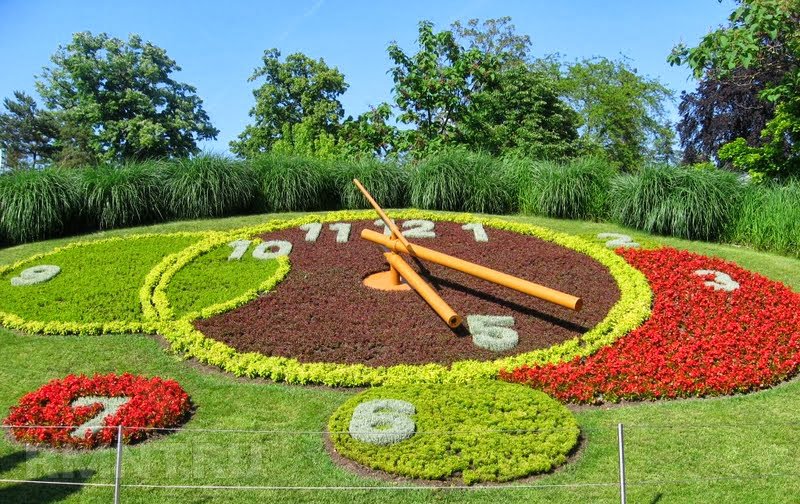 Of course, for greater clarity, you can arrange a flower garden in the form of a dial with arrows. But this is already a regular flower bed, which you will not find in an ordinary summer cottage - this is a task for professionals. So just collect plants on one flower garden that you know exactly what time they open and close - you will be perfectly oriented without wrist watch while working on the site. In addition, a clock flower garden will allow you to surprise your guests - in fact, how did you know that it was seven in the evening if you did not even look at the screen of your mobile phone?
Of course, for greater clarity, you can arrange a flower garden in the form of a dial with arrows. But this is already a regular flower bed, which you will not find in an ordinary summer cottage - this is a task for professionals. So just collect plants on one flower garden that you know exactly what time they open and close - you will be perfectly oriented without wrist watch while working on the site. In addition, a clock flower garden will allow you to surprise your guests - in fact, how did you know that it was seven in the evening if you did not even look at the screen of your mobile phone?
 When choosing plants for flower hours, remember that, for example, bindweed opens daily at eight in the morning, field carnation at one in the afternoon is already closed from the heat, forget-me-not closes at five in the evening, and daylily - at seven.
When choosing plants for flower hours, remember that, for example, bindweed opens daily at eight in the morning, field carnation at one in the afternoon is already closed from the heat, forget-me-not closes at five in the evening, and daylily - at seven.
Solitaire flower garden
A solitaire flower garden can be called one of the most concise options for decorating a site. Such a flower garden is a lonely, rather large and noticeable plant, in extreme cases - a small group of three or four equally tall flowers.
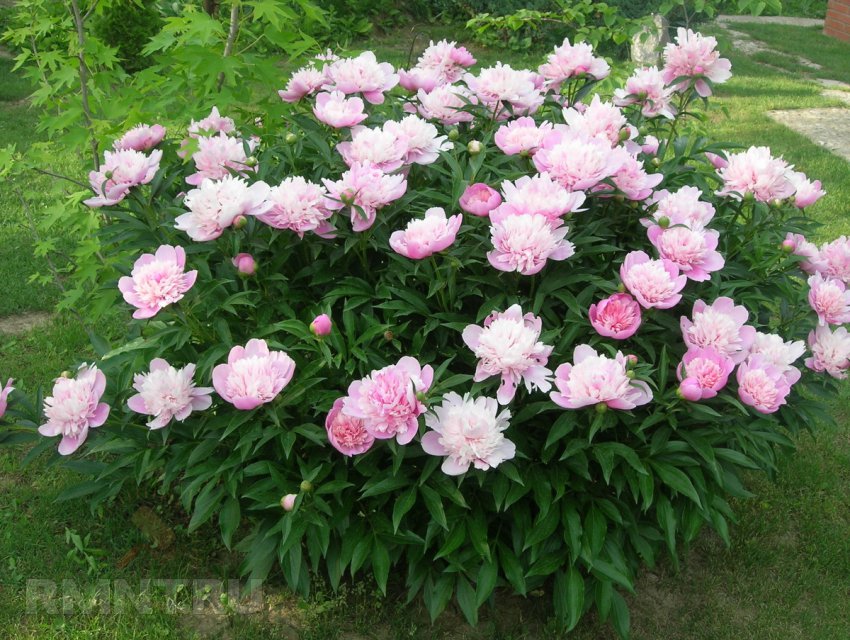 The arrangement of a solitaire flower garden does not require almost any effort - just choose a free place on the site and land suitable plant. This version of the flower garden does not require a fence, no borders, no MAFs, and is widely used in a variety of styles of landscape design.
The arrangement of a solitaire flower garden does not require almost any effort - just choose a free place on the site and land suitable plant. This version of the flower garden does not require a fence, no borders, no MAFs, and is widely used in a variety of styles of landscape design.
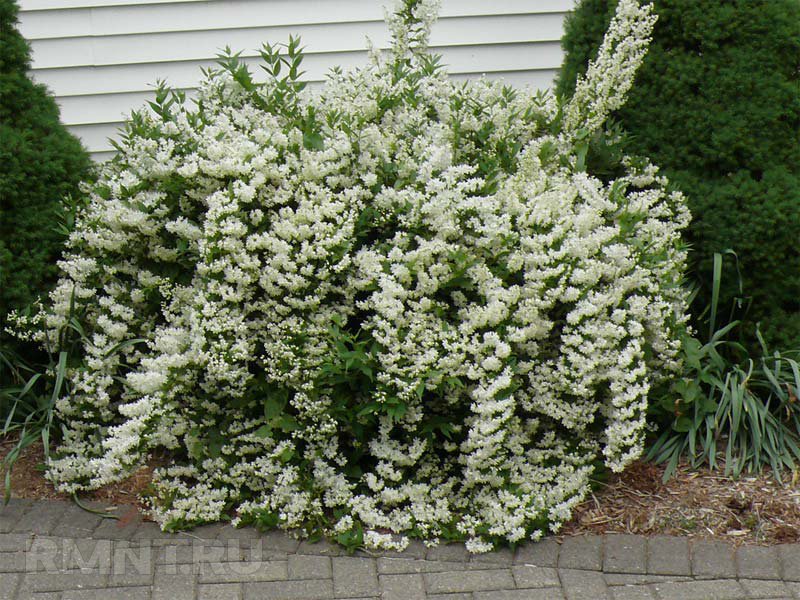 Flowering shrubs are perfect for a solitaire flower garden, for example, broom, panicled hydrangea, delphinium. You can also choose a lush bush of peonies or roses, a lily, a group of irises, an ash tree or a rudbeckia.
Flowering shrubs are perfect for a solitaire flower garden, for example, broom, panicled hydrangea, delphinium. You can also choose a lush bush of peonies or roses, a lily, a group of irises, an ash tree or a rudbeckia.
Most hosts personal plots, planning to break a flower garden, they mean arranging an ordinary flower bed, not even knowing what a large number of types and options offers them a modern landscape design. Now that you are familiar with the varieties of flower beds, we are sure that your site will acquire one more decoration, it will become more original and bright.
Anna Sedykh, rmnt.ru
(page 1 of 35)© G.A. Kizima, 2017
© AST Publishing House LLC, 2017
Vegetable garden, garden
From the author
I am an engineer-physicist by education, I graduated from the Faculty of Physics and Mechanics of the Leningrad Polytechnic Institute, which prepared for research work which helped me a lot in my life. So I don’t have any agronomic education, but I have an indestructible curiosity. Here she is my inner drive.
I was introduced to mini-agriculture by my mother, who, having received our first garden plot 55 years ago, she immediately sent me to the Riga gardening club for gladiolus bulbs. It was there that I met an amazing tribe of people called "amateur gardeners." In the meantime, I was driving home in a common carriage at night, thinking how and where I would plant these wonderful flowers, and at the same time I planned my first six-hundred plot. So I have a very solid experience as an amateur gardener. The passion to experiment and analyze was instilled in me during my student years, and natural curiosity completed everything else.
My wonderful six acres is still the only hobby that has become my profession. After all, only gardening really occupies me, but what a multifaceted occupation it is!
This book is written by an amateur gardener for amateur gardeners with only six acres of land. Features of managing on small area forced me to critically rethink many of the recommendations of agricultural scientists, because they were developed for huge farms. As a rule, these methods did not justify themselves on small plot and sometimes even harmed. I had to turn to the collective experience of amateur gardeners. Having tested for a number of years on my site many of the advice of scientists, practicing agronomists and amateur gardeners, I left in my arsenal only those that justified themselves on my six acres. As a result, the idea came up to write a book that summarizes both my personal 55-year experience and the experience of many, many gardeners and gardeners who generously shared their findings with me, for which I am grateful to them.
Galina Aleksandrovna Kizima
Chapter first
Good site planning is the key to success

Very often, when they receive a plot, gardeners begin to build and plant at the same time, and they plant it any way and wherever they want, since almost all the space is occupied by building materials. This is a bug that will take a lot of time and effort to fix. Others, on the contrary, only build and plant nothing. This is also a mistake, because the construction is delayed for several years, and the trees also grow for several years before they begin to bear fruit. So it turns out that many are sitting in a great house and waiting for the harvest.
But it all starts with the layout of the site.
To do this, take a sheet of paper, draw your area on it on a scale, indicate the cardinal points. Then it is necessary to cut out pieces of paper on the same scale corresponding to the house, shed, garage or car park, toilet, playground or recreation area, pond, well and place them on the site plan in accordance with the general gardening layout. The reservoir should be located near the house, greenhouses and gardens, so that water is always at hand for irrigation and in case of fire. Greenhouses should be located so that they are always in the sun. You can't dig a well wherever you want - they dig it where water is found. To do this, pay attention to where large trees grew, where midges wind in a column in the evening. Another way is to walk around the site with a metal frame in your hands - let all members of your family do this independently of each other. The frame is made of two wires bent in the form of the letter L from any metal except aluminum. They take the short ends into loosely clenched fists and direct the long ends forward parallel to each other. When you walk around the site, the free ends of the wires will turn, and over the place where there is water, they will cross. Mark these places on the plan and choose the place for the well where everyone had matches; also consider what was said above. Now you have to decide which type of layout you prefer: landscaped or regular. When landscape planning, trees and shrubs are arranged in an arbitrary order as they grow in nature: one apple tree or a group of apple trees in one place, the other in another. But I’ll say right away that it is difficult to implement this type of layout in a small area, since it is necessary to take into account not only the factor of good illumination of all landings, but also their compatibility with each other. Therefore, it is better to take a regular layout as a basis and leave only a small part for the recreation area. Draw future paths on the plan and place buildings.
The main thing in planning is the reasonable use of space
First, decide which and how many trees you want to place on your site, and then cut out the required number of circles from paper and lay them out on the plan. It is more convenient to care for apple and pear trees if they are located in one place or along the path. It is better to plant them on the south side of the house to cover them from the northern winds. Stone fruits should be planted away from pome fruits. Cherries should not be planted in a space open to the north wind, where the air stagnates or, conversely, drafts blow. For them, you need to look after a place protected from the north wind by other trees or buildings. Cherry grows well near buildings, for example, on the south side of the barn. Sea buckthorn, irga, chokeberry, red rowan- plants are frost-resistant, so they are planted on the north side of the site, if only there was sun.
From the northern shady side of the house you can plant shade-tolerant plants: red viburnum, by the way, in the shade it is less damaged by pests, virgin and Chinese bird cherry, a hybrid of bird cherry with cherries, the wall of the house can be twined with honeysuckle - climbing honeysuckle. You can make a small flower garden from ferns, bergenia, bathing suit, marigold, watersheds, primroses and astilba or other shade-tolerant flowers.
berry bushes it is necessary to plant along the border of the site, stepping back from the edge of 1.5 m, then your green fence will fence you off from your neighbors and will not cause any complaints from them, since you will not have to cross the border of the site to pick berries and the bushes will not give shade to the neighboring plot. Trees should be placed no closer than 3 meters from the border for the same reasons. Honeysuckle and redcurrant love the sun, and gooseberries, raspberries and blackcurrants are quite reconciled with partial shade, so they can be planted in the aisles of apple trees. Walnut does not like the neighborhood of coniferous crops, he needs the sun. Strawberries came to us from the forest, so it is quite possible to place them between apple trees, they live well in partial shade.
peonies should not be planted closer than 2 m from the walls of buildings or trees, otherwise they will not bloom. Roses definitely need the eastern sun. All bulbous, in addition to gladioli, you can plant under trees, they have time to bloom before the trees become leafed and create shade.
Cannot be planted on site lilac and leave birch or pine. They have a powerful root system that spreads up to 15–17 m around and takes away fruit plants food and moisture. In addition, carrot psyllid, currant columnar rust, and many garden pests overwinter on the pine. But Christmas tree you can leave it on the site, but you must definitely limit its root system and growth. To do this, at a distance of a meter from the trunk, you need to dig in slate or make concrete masonry around the Christmas tree and pinch off the top and young shoots at the ends every spring - the Christmas tree will turn into a compact spherical bush, besides, it will not dry out the lower branches. You can’t plant hawthorn on the plot, it will attract many pests of apple trees, you can’t leave ordinary bird cherry - it will attract a glass box that damages blackcurrants, you can’t leave buckthorn - goblet rust winters on it, turning into currants and gooseberries in spring.
Under potatoes, cabbage, onions should be left in an open sunny place, but garden greens, except for dill, as well as beets and carrots, will completely tolerate slight or temporary shading.
flower beds and playground they should be located so that the midday sun does not fall on them and thorny plants should not be planted near the playground.
After you have placed all your plantings on the plan, you can start uprooting the site, laying paths in the first place, making room for a house, a barn, a toilet. Warehouse Construction Materials at the parking lot for the car, at the site of the future barn, at the end of the paths. Immediately burn the trash left from uprooting, and collect the ashes in metal barrels and cover.
Rake up your seat apple trees and start planting no more than two per year or every other year. The garden should be of different ages. shrubs also plant gradually, carefully choosing varieties, never plant anything - nothing but disappointment will bring you. In the first year, you need to plant the first bed of strawberries, adding a bed every year.
While building a house and a garden will grow up. In the early years, do not strive to master the entire garden at once, act on the principle of "better less, but better."
Norms of consumption of berries, vegetables and fruits. The number of plants required for this and the area for their cultivation
Table 1. Norms of consumption of berries, vegetables and fruits. The number of plants required for this and the area for their cultivation

An approximate assortment of plants for the garden: summer apple trees 1–2, autumn apple trees 2–4, winter apple trees 1–2, pears 2, plums 2–3, cherries 3–4, sea buckthorn 2 g. + 1 m., red currant 2, black currant 6–8, gooseberry 4–6, honeysuckle 2–3, raspberry 20–30, wild strawberry 250, red ashberry 1, chokeberry 2, Japanese quince 1, hazelnut 2, wild rose 2.
Approximate distribution of land on a plot of 6 acres for a family of three:

Pineapple is not for us
Many gardeners are tempted to plant something on the plot that no one else has, and they plant apricots, peaches, grapes, pineapples, peanuts, and even walnuts. As a result, having spent a lot of effort and money on this whim, they most often experience disappointment. At one time, I also went through many temptations and disappointments, and therefore I want to warn you: do not try to jump above your head. Everything, of course, can be tried, this has its own charm, but if you want to do such research, then do it properly and first prepare well. There are such wizards in the North-West who grow grapes and apricots, but this is not at all easy - special tricks and skill are needed here. At one time, the monks on Valaam grew watermelons, and even in open field, pineapples and other overseas curiosities grew in the greenhouses of St. Petersburg, and apricots and peaches were grown in Petrodvorets. But for a successful guaranteed harvest, you still need to use only zoned and well-established varieties of vegetables, berries and fruits. Even what grows well in Moscow is not at all suitable for St. Petersburg, to say nothing of southern varieties or foreign ones, except for those grown in Finland. So not every pineapple is for us.
Where to put old galoshes?
Finally, let's talk a little about the ecology on the site and the land adjacent to it. It's no secret that we have literally polluted the surroundings of our gardens. There are no words, this is the fault of the horticultural leaders who failed to properly organize places for garbage dumps and their disposal, but our fault is enormous. Almost everything can be disposed of on your own site. The old plastic film can be used for a long time after it has been removed from the greenhouses: cover the beds for the early cultivation of weeds with their subsequent destruction, cover the tree trunks until flowering in order to prevent pests from leaving the soil, line the bottom of the beds, isolating early vegetables from cold bottom layer and finally burn in small portions. When the film is oxidized, water and carbon dioxide, and the combustion process is largely an oxidation process. Of course, during combustion, a certain amount of dioxin is released, but really, it is not fatal and not hazardous to health.
But the glass cullet does not have to be taken out or taken out of the site, you just need to take an old bucket under it and use it for any concrete work, which from time to time still have to be produced.
Plastic bottles should be used for drainage, drinking bowls and dressings for plants, because a bottle of water, stuck with an open neck into the soil near the plant, plays the role of drip irrigation and saves us from unnecessary work on watering the garden. It is also convenient to use plastic bottles for growing seedlings by cutting off the tapering part.
After firing in a fire, metal cans can be easily flattened and simply buried under the trees - after a couple of years there is not a trace left of them.
Old shoes can be buried at the base of a raised bed or around trees, old clothes can be placed at the base of pumpkin and squash beds, and paper junk can be burned in a fire or buried under soil in greenhouses as biofuel.
For forty years I have not taken out a single trash can from the site, everything has been used and at the same time there is no rubbish on my site - everything is disposed of in one way or another. Is it really pleasant to live among the garbage dumps, landfills, dirt and garbage that we plant around ourselves? You can even bury an old car, and not just a refrigerator, a baby bath or a holey basin. You just have to remember that my plot or apartment is in my house, my garden, my city or village, in my country and on my planet, and no one will keep it clean and tidy for me.
Chapter Two
The earth is the most important
Everyone knows that good soil is the main thing for a crop, but not everyone knows how to prepare this very good soil before planting. Somehow they dig up the one that is, stick into it what they have to, and wait for the harvest, and they are also surprised that nothing grows.
Whether you like it or not, you have to prepare the ground for a good harvest. It is no secret that land for gardening is allocated completely unsuitable for agriculture, usually on peat bogs, or on barren sands and clays, or in a poor aspen forest on lean podzolic soils. And this country will require ten years of hard labor before it becomes more or less suitable for agriculture. But this is how a person is arranged: often even an unconscious craving for the earth lives in him, and as soon as the gardener gets his piece of land, there appears, out of nowhere, a force mixed with enthusiasm to work on it. You look - and ten years later the gardens are already rising, and the land has become fertile, and the inept townspeople have learned to grow such crops that even an experienced villager is a wonder. And what just does not grow in our gardens! But everything starts from the ground.
What are the main characteristics of the soil? First of all, this is its mechanical (granulometric) composition, but the structure, moisture capacity, acidity, and availability of nutrients are also important. First you need to determine the mechanical composition and acidity of your soil, and only then take on its improvement.
The mechanical composition of the soil and its improvement
To determine the mechanical composition, you need to take a lump of moistened soil, roll it into a sausage in your palms and connect the ends. If you get a ring - your soil is clay, if faults have formed in the ring - the soil is loamy, if the ring crumbled into pieces - sandy loam, but if the sausage does not roll at all - then sandy. Only medium and light loams are suitable for agriculture. The rest of the soil needs to be improved.
AT clay soil you will have to bring in one bucket of any organic matter and a bucket of coarse sand for each square meter under the dig. Unfortunately, it is necessary to do this every year, because the plants will safely use the organic matter for their needs, and the sand will gradually seep down and you will again have only clay on the beds. Sanding clay soils requires up to 150 kg of sand for every square meter of clay soil surface, so you will need to apply a bucket of sand every year for every meter for 10-15 years.
So is it necessary to dig clay soil, and even twice a year: in spring and autumn? I think no. Why do we need such hard labor? It is better to make alluvial soil for greenhouses and beds once, using the advice of the American scientist Jacob Mitlider. We will discuss this in more detail in Section 14.
Sandy but the soil must be tied up, otherwise no matter how much water you pour into it, why not rash - everything will pass through it as dust. It is necessary to add a bucket of clay and organic matter to the sand for every meter for digging; in the future, usually clay will need to be applied from time to time, but organics will have to be applied annually. In addition, magnesium must also be added, which the sands are very poor in. But there is one small detail. Clay clods are very difficult to evenly mix with the soil, so it is easier to dilute the clay with water, and then water and water your sands. In clay, by the way, there are a lot of mineral salts. It binds well sandy soil and sapropel - bottom silt from water bodies, including drainage ditches dug along internal gardening roads. When it is applied, organic matter is no longer required, because the silt itself is a good fertilizer. But silt is usually acidic and contains an excess of gases, so it must be weathered for a year before use - so let it lie along the ditches after cleaning them. Then you need to add a deoxidizer and only after that use sludge. It is very useful to add sphagnum moss to sandy soils, as it perfectly retains moisture and nutrients that are not retained by sand. In addition, moss has powerful bactericidal properties and disinfects the soil from pathogens, but first it must be soaked in a solution of urea (10 tablespoons per bucket of water) or in a solution of urine (dilute urine with water in a ratio of 1: 2).
Peatlands usually have a loose permeable structure that does not require much improvement, besides, they are quite fertile (with the exception of high-moor peat), but they are poor in copper, phosphorus and potassium, so they also need to be applied annually. Peatlands will also not be harmed by the annual application of half a bucket of sand and organic matter per meter, since peat soil is depleted by about 2–3 cm per year. Thus, in ten years it will be 20-30 cm lower than it was before development, and will become waterlogged. They require peat bogs, especially raised bogs, and annual deoxidation.
What can be taken as organic matter to improve the mechanical composition of the soil? What you have on hand. It can be tree bark, shavings left over from construction or coniferous needles. If there is a coniferous forest nearby, then go and collect them as needed, and if there is a swamp nearby, then use sphagnum moss. Leaves can also be used if there is a deciduous forest nearby. Birch leaves are especially good, like moss, which have bactericidal properties. In general, you can use any leaves, except for oak, due to the high content of tannins in them, which inhibit plant growth. And it is absolutely impossible to use the foliage of city or suburban parks, since this is a real accumulation of toxic emissions from industrial enterprises and cars. Sawdust, better rotted, can also be introduced into the soil. It may not be rotted, but in this case, as with the introduction of fresh shavings or sphagnum moss, it is necessary to pre-soak these shavings and sawdust with water and urea (10 tablespoons of carbamide per 10 liters of water) or urine diluted with water 1: 2. The fact is that fresh shavings and sawdust contain a lot of carbon, which is a good food for soil microorganisms, which then begin to develop rapidly. But in addition to carbon, these microorganisms also need nitrogen, which is scarce in fresh sawdust and shavings, so the microorganisms will begin to absorb nitrogen from environment, which will lead to nitrogen starvation of plants on this soil. The best organic matter is, of course, leaf humus, rotted compost and manure, as well as sawdust and shavings left after growing oyster mushrooms on them.
If you use peat as organic matter, then pay attention to which one you have. Lowland peat is dark brown in color and rich in nutrients. The fact is that such peat is formed with water replenishment from below, from a mineral-rich parent rock, and therefore is saturated with nutrients. If you rub a wet lump of low-lying peat in your palms, and then shake your hands off, a greasy trace will remain on your palms.
High-moor peat has a rusty-brown color and is poor in nutrients, since it is formed in the lowlands, under which the clay layer lies, and water saturated with mineral compounds does not penetrate into it from below. The raised bog is formed due to rainwater, which practically does not contain nutrients. Basically, it is used only to cover the soil from above (for mulching). If you rub a wet ball of high-moor peat in your palms, and then shake your hands off, they will be clean.
Before introducing peat into the soil as organic matter, it must be weathered. It is better not to introduce rusty peat into the soil, since it contains an excess of iron, which is harmful to plants.
Anyone who has a summer cottage or personal plot knows in practice how important it is to properly organize a garden from the very beginning, a vegetable garden, a flower garden, so as not to uproot already grown trees, not to endure the garden due to an unfortunate location and the flower garden did not interfere, but pleased the eyes. I will talk about this using the example of my personal plot.
Many novice summer residents and owners, having acquired land plot, having only roughly outlined a place for the future home, having estimated by eye where it will be, they immediately begin to acquire seedlings of trees and shrubs.
All these seedlings are planted on the intended area of the garden, trying to immediately fill it with all kinds of fruit trees, while often not maintaining the necessary distances between them.
And when the trees grow to their standard sizes, then the garden, as a rule, is already very thickened and requires, and very often, the uprooting of several already mature trees. Wasted money, strength, and an adult tree dies. Problems also often arise with the garden, it is not always located in the optimal place, where nothing prevents the plants from growing well and bearing fruit abundantly.
They fill in the remaining, often unsuitable for them places. Any garden garden flower garden requires, taking into account the observance of favorable conditions for full growth, that our gardens give us delicious fruits, vegetable gardens bear fruit abundantly, and flower gardens delight us all year round a riot of colors.
And after all, this is an easily solvable task, you just need to think carefully about the entire summer cottage or garden plot, draw a plan for the placement of the house, outbuildings, draw where the paths will be, what fruit trees we want to have in our garden, what berries we love, what vegetables will grow on our beds.
Correctly arrange the garden garden flower garden - less hassle later
When my family and I received a plot of land for building a house in autumn, there was a great temptation to start a garden right away, autumn is a good time for planting trees. But he held on. I divided the plot into three parts: a garden, a house and a vegetable garden.
Where I planted a garden, there was a very small layer of fertile land;
And where he wanted to arrange a garden, the neighbors had an old garden. Therefore, I transferred all the work to the next spring, and during the winter I thought out a plan for placing flower beds on the site of the house, the garden.
And in the spring, I already knew for sure that the garden would be located on the same side as the neighbors, the trees would not shade each other, that I would plant four peaches, one cherry, two apple trees and two pears, but with different fruit ripening periods. This amount of fruit is enough for our family. The garden will be laid out in the lower part of the site using the technology of narrow beds.
I placed it along the north-south axis and from early morning until late evening they will be illuminated by the sun, protected by a fence from the north winds, along the fence I poured concrete high beds for growing black and red currants, gooseberries in them. They love moisture and a thick layer of mulch, which is great for raised beds.
On the beds arranged drip irrigation from a plastic container. A very important role in the placement of a vegetable garden and flower beds is played by the illumination of plants by the sun.
My flower beds occupy the area in front of the house, some of the flower beds are illuminated by the sun all day, and along the street fence only in the morning. Therefore, we plant flowers according to the need for lighting.
A genus of perennial bulbous herbs of the lily family. In beauty, lily flowers compete with orchids, but they are far from being so capricious and demanding to care for.
Lily flowers have always amazed the imagination of people with their unusual beauty. The capital of the ancient Persia was the city Susa, which means the city of lilies ( Susan or Shushun in the ancient language of the Persians called lily flowers). In France, before the revolution, lilies were a symbol of royal power. The lily flower is present on the coats of arms of many noble families in different countries.
White Lily- The lily of the Madonna among Christians is considered the flower of the Virgin Mary, as a symbol of purity and purity.
Among the Chinese, very small legs were considered the most beautiful and attractive part of a woman’s body, which, with the help of bandages, were given an unusual pointed shape with an unnaturally curved instep and four fingers bent inside the foot. These legs are called golden lotus" or " golden lily". Only the leg golden lily” guaranteed in quite recent times a successful marriage for Chinese women.
The name Lily is called girls, meaning that they will grow up as beautiful and tender as this flower.
A bouquet of white lilies symbolizes beauty, purity of thoughts, fidelity and devotion.
- a flower widespread in the Northern Hemisphere, where it grows about 100
its wild species. From them came numerous hybrid varieties, which are often named after their place of origin. Oriental hybrids obtained from wild lilies in China and Japan, Asian hybrids- the most numerous and most unpretentious group of hybrids. tubular hybrids, named after the shape of the flower. Hybrids derived from these hybrids - for example Orienteps(result of crossing Oriental and Tubular hybrids) etc.
The ground part of the lily consists of a stem, the height of which, depending on the variety, can be from 30cm, before 200cm. The leaves are usually lanceolate, curved. Flowers from 5
before 25 cm in diameter are made up of 6
tepals, which can be in the form of a wide-open bowl, funnel, bell. The edges of the leaves of the bract may be smooth or strongly curved outwards. Usually several flowers bloom at once, which form a real bouquet of lilies on the stem. Inside the flower is a sweet nectar that attracts pollinators. The stamens, on long stalks, are located around the pistil with a thick three-lobed stigma. The fruit is a seed pod with many flat seeds.
underground part lily consists of roots and a bulb, which is formed in the first year of planting from a seed, but until the bulb reaches sufficient size (through 3-4 years), the lily does not bloom or blooms weakly. After the size of the bulb has reached the right sizes The lily blooms every year. Both seeds and bulbs of lilies are suitable for obtaining new plants, but most often reproduction of lilies is carried out by bulbs, because. in this case, species differences are better preserved. Although lilies grown from seeds are less susceptible to viral diseases.



